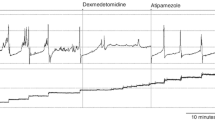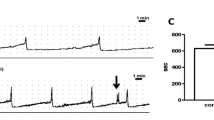Abstract
PURPOSE: Patients with chronic anal fissures are known to have high resting anal pressures that return to normal after successful surgical treatment. Internal anal sphincter activity is increased by sympathetic excitatory innervationvia alpha adrenoceptors. The objective of this study was to determine the effect of alpha-1 adrenoceptor blockade on anal sphincter pressure in patients with and without chronic anal fissures. METHODS: The effect on the anal canal pressure profile of a single oral 20 mg dose of indoramin, an alpha-1 adrenoceptor antagonist, on seven patients with chronic anal fissure and six healthy patients without a fissure was investigated. RESULTS: Indoramin reduced anal resting pressures in those with anal fissure by a mean of 35.8 percent, from 106.9 ± 22.15 cm H2O to 68.6 ± 20.35 cm H2O, and in those without anal fissure by a mean of 39.9 percent, from 84.17 ± 27.46 cm H2O to 52.17 ± 24.78 cm H2O, after one hour. This pressure reduction persisted at three hours, and its magnitude is comparable to that obtained after internal sphincterotomy. The pressure reduction occurred over the whole length of the anal canal. CONCLUSION: It is proposed that alpha-1 adrenoceptor antagonists could be a suitable treatment for chronic anal fissure and other painful conditions where reduction in anal pressure is warranted.
Similar content being viewed by others
References
Gibbons CP, Read NW. Anal hypertonia in fissures: cause or effect? Br J Surg 1986;73:443–5.
Penninckx F, Lestar B, Kerremans R. The internal anal sphincter: mechanisms of control and its role in maintaining anal continence. Baillieres Clin Gastroenterol 1992;6:193–214.
Littlejohn DR, Newstead GL. Tailored lateral sphincterotomy for anal fissure. Dis Colon Rectum 1997;40:1439–42.
Oh C, Divino CM, Steinhagen RM. Anal fissure. 20-year experience. Dis Colon Rectum 1995;38:378–82.
Khubchandani IT, Reed JF. Sequelae of internal sphincterotomy for chronic fissure in ano. Br J Surg 1989;76:431–4.
Garcia-Aguilar J, Belmonte C, Wong WD, Lowry AC, Madoff RD. Openvs. closed sphincterotomy for chronic anal fissure: long-term results. Dis Colon Rectum 1996;39:440–3.
Lund JN, Scholefield JF. A randomized, prospective, double-blind, placebo-controlled trial of glyceryl trinitrate ointment in treatment of anal fissure. Lancet 1997;349:11–4.
Maria G, Cassetta E, Gui D, Brisinda G, Bentivoglio AR, Albanese A. A comparison of botulinum toxin and saline for the treatment of chronic anal fissure. N Engl J Med 1998;338:217–20.
Loder PB, Kamm MA, Nicholls RJ, Phillips RK. “Reversible chemical sympathectomy” by local application of glyceryl trinitrate. Br J Surg 1994;81:1386–9.
Watson SJ, Kamm MA, Nicholls RJ, Phillips RK. Topical glyceryl trinitrate in the treatment of chronic anal fissure. Br J Surg 1996;83:771–5.
Frenkner B, Ihre T. Influence of autonomic nerves on the internal anal sphincter in man. Gut 1976;17:306–12.
Gutierrez JG, Shah AN. Autonomic control of the internal anal sphincter in man. In: G. Vantrappen, ed. Fifth international symposium of gastrointestinal motility. Herentals: Typoff-Press, 1975:363–73.
Yamato S, Rattan S. Role of alpha adrenoceptors in opossum internal anal sphincter. J Clin Invest 1990;86:424–9.
McNamara MJ, Percy JP, Fielding IR. A manometric study of anal fissure treated by subcutaneous lateral internal sphincterotomy. Ann Surg 1990;211:235–8.
Williams N, Scott NA, Irving MH. Effect of lateral sphincterotomy on internal anal sphincter function: a computerized vector manometry study. Dis Colon Rectum 1995;38:700–4.
Schouten WR, Briel JW, Auwerda JJ, De Graaf EJ. Ischemic nature of anal fissure. Br J Surg 1996;83:63–5.
Xynos E, Tzortzinis A, Chrysos E, Tzovaras, Vassilakis JS. Anal manometry in patients with fissure-in-ano before and after internal sphincterotomy. Int J Colorectal Dis 1993;8:125–8.
Gui D, Cassetta E, Anastasio G, Bentivoglio AR, Maria G, Albanese A. Botulinum toxin for chronic anal fissure. Lancet 1994;344:1127–8.
Reynolds JE, Martindale W, eds. The extra pharmacopoeia. 30th rev. ed. London: The Pharmaceutical Press, 1993:365.
Chow W, Hahn D, Sandhu D,et al. Multicentre controlled trial of indoramin in the symptomatic relief of benign prostatic hypertrophy. Br J Urol 1990;65:36–8.
Author information
Authors and Affiliations
About this article
Cite this article
Pitt, J., Craggs, M.M., Henry, M.M. et al. Alpha-1 adrenoceptor blockade. Dis Colon Rectum 43, 800–803 (2000). https://doi.org/10.1007/BF02238017
Issue Date:
DOI: https://doi.org/10.1007/BF02238017




